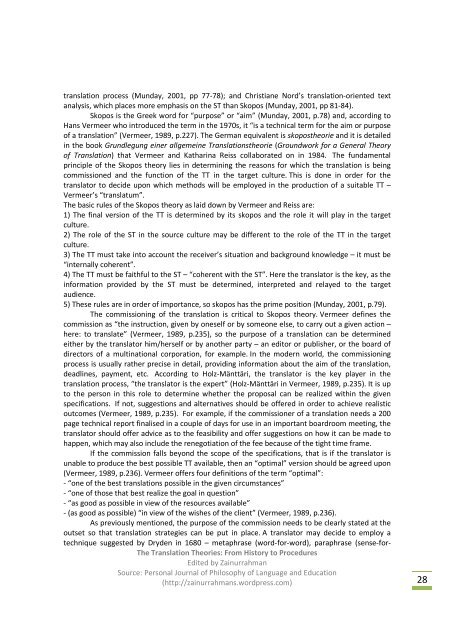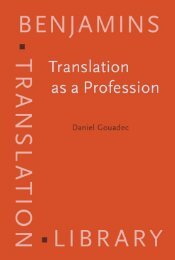Translation Theories.pdf
Translation Theories.pdf
Translation Theories.pdf
You also want an ePaper? Increase the reach of your titles
YUMPU automatically turns print PDFs into web optimized ePapers that Google loves.
translation process (Munday, 2001, pp 77-78); and Christiane Nord’s translation-oriented text<br />
analysis, which places more emphasis on the ST than Skopos (Munday, 2001, pp 81-84).<br />
Skopos is the Greek word for “purpose” or “aim” (Munday, 2001, p.78) and, according to<br />
Hans Vermeer who introduced the term in the 1970s, it “is a technical term for the aim or purpose<br />
of a translation” (Vermeer, 1989, p.227). The German equivalent is skopostheorie and it is detailed<br />
in the book Grundlegung einer allgemeine <strong>Translation</strong>stheorie (Groundwork for a General Theory<br />
of <strong>Translation</strong>) that Vermeer and Katharina Reiss collaborated on in 1984. The fundamental<br />
principle of the Skopos theory lies in determining the reasons for which the translation is being<br />
commissioned and the function of the TT in the target culture. This is done in order for the<br />
translator to decide upon which methods will be employed in the production of a suitable TT –<br />
Vermeer’s “translatum”.<br />
The basic rules of the Skopos theory as laid down by Vermeer and Reiss are:<br />
1) The final version of the TT is determined by its skopos and the role it will play in the target<br />
culture.<br />
2) The role of the ST in the source culture may be different to the role of the TT in the target<br />
culture.<br />
3) The TT must take into account the receiver’s situation and background knowledge – it must be<br />
“internally coherent”.<br />
4) The TT must be faithful to the ST – “coherent with the ST”. Here the translator is the key, as the<br />
information provided by the ST must be determined, interpreted and relayed to the target<br />
audience.<br />
5) These rules are in order of importance, so skopos has the prime position (Munday, 2001, p.79).<br />
The commissioning of the translation is critical to Skopos theory. Vermeer defines the<br />
commission as “the instruction, given by oneself or by someone else, to carry out a given action –<br />
here: to translate” (Vermeer, 1989, p.235), so the purpose of a translation can be determined<br />
either by the translator him/herself or by another party – an editor or publisher, or the board of<br />
directors of a multinational corporation, for example. In the modern world, the commissioning<br />
process is usually rather precise in detail, providing information about the aim of the translation,<br />
deadlines, payment, etc. According to Holz-Mänttäri, the translator is the key player in the<br />
translation process, “the translator is the expert” (Holz-Mänttäri in Vermeer, 1989, p.235). It is up<br />
to the person in this role to determine whether the proposal can be realized within the given<br />
specifications. If not, suggestions and alternatives should be offered in order to achieve realistic<br />
outcomes (Vermeer, 1989, p.235). For example, if the commissioner of a translation needs a 200<br />
page technical report finalised in a couple of days for use in an important boardroom meeting, the<br />
translator should offer advice as to the feasibility and offer suggestions on how it can be made to<br />
happen, which may also include the renegotiation of the fee because of the tight time frame.<br />
If the commission falls beyond the scope of the specifications, that is if the translator is<br />
unable to produce the best possible TT available, then an “optimal” version should be agreed upon<br />
(Vermeer, 1989, p.236). Vermeer offers four definitions of the term “optimal”:<br />
- “one of the best translations possible in the given circumstances”<br />
- “one of those that best realize the goal in question”<br />
- “as good as possible in view of the resources available”<br />
- (as good as possible) “in view of the wishes of the client” (Vermeer, 1989, p.236).<br />
As previously mentioned, the purpose of the commission needs to be clearly stated at the<br />
outset so that translation strategies can be put in place. A translator may decide to employ a<br />
technique suggested by Dryden in 1680 – metaphrase (word-for-word), paraphrase (sense-for-<br />
The <strong>Translation</strong> <strong>Theories</strong>: From History to Procedures<br />
Edited by Zainurrahman<br />
Source: Personal Journal of Philosophy of Language and Education<br />
(http://zainurrahmans.wordpress.com) 28

















